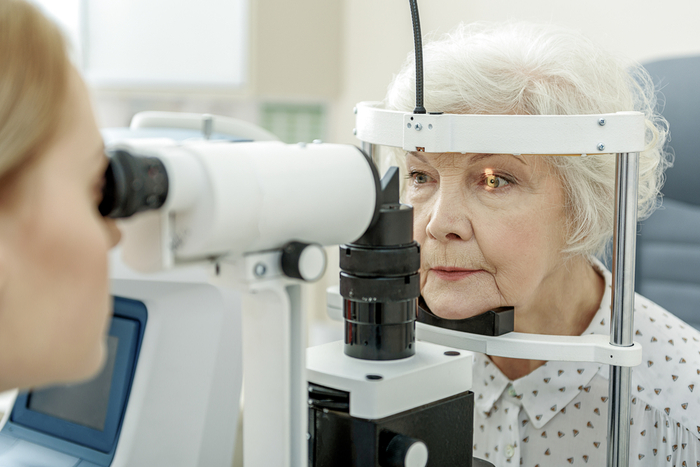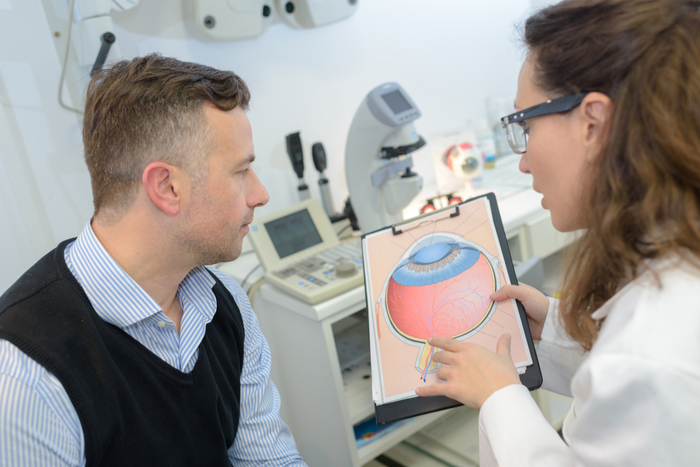Over 3 million Americans — most of whom are over age 40 — live with Glaucoma. Glaucoma is a degenerative disease that progressively degrades the cranial nerves. The disease can cause severe damage to one’s vision and is one of the most common causes of blindness not only in the U.S. but in the world. In this article, we’ll address whether combining glaucoma and marijuana is helpful. First, let’s further explore glaucoma as a condition, including causes and risk factors.
Glaucoma is a hereditary disease. According to the Glaucoma Research Foundation, the heritability of glaucoma has thus far made it nearly impossible to find effective ways to prevent onset. Nor is glaucoma currently curable. However, with early detection and a treatment plan, patients can manage their symptoms and prevent severe vision loss and irreversible blindness.
While there are two primary forms of glaucoma — open-angle and angle-closure — open-angle is the most common diagnosis, affecting 95 percent of the patient population.

Glaucoma Risk Factors & Causes
Glaucoma is associated with elevated eye pressure, specifically intraocular pressure (IOP). However, contrary to popular perception, high IOP isn’t the cause of glaucoma. People with normal eye pressure can be diagnosed with glaucoma, while people with high IOP may not be diagnosed with glaucoma. It is, however, a risk factor for developing glaucoma. It can also exacerbate symptoms, causing compression that can degrade or destroy the retina and optic nerves’ fibers.
What Causes Glaucoma?
What causes glaucoma largely depends on which of the three types of glaucoma you have. However, the precise causes of glaucoma have been hard to pinpoint. The most current research from MIT and Massachusetts Eye and Ear (a Harvard teaching hospital focused on ophthalmology) suggest glaucoma-related vision loss is caused by an immune response to early exposure of bacteria.
According to Dr. Dong Feng Chen, the lead vision scientist on the study, and Harvard Medical School professor, the autoimmune attack can cause nausea, severe eye pain, and vision disturbances.
“The fact is, eye pressure is only a risk factor, which means only a small percentage of people who have elevated ocular, or eye pressure, actually develop glaucoma,” claims Dr. Chen. “Our study actually shows that the elevated eye pressure does not naturally lead to glaucoma.’
Dr. Dong Feng Chen
While there’s currently no known cure for glaucoma, Dr. Chen’s research has made him optimistic that a cure is in sight: “Targeted manipulation of the immune response in the eye will help eliminate the disease.”
Risk Factors
- Family history and genetics
- Age (60+)
- High blood pressure
- Elevated eye pressure
- Thin cornea
- Persistent high-stress

Glaucoma and Marijuana
In most states where medical cannabis is legal, glaucoma is a qualifying condition, meaning glaucoma patients are eligible to become medical cannabis patients. But what does the science say? Is cannabis a viable treatment? Well, it depends on who you ask.
Studies into glaucoma and marijuana from the 1970s were promising; they found that cannabis does, in fact, lower IOP. However, as research has progressed and new medications have been developed, the current consensus in the ophthalmology community is that marijuana isn’t more effective than currently available drugs. Nor do most ophthalmologists believe cannabis should be used as a first-line or primary treatment.
Most ophthalmologists and researchers cite the short duration of cannabis and accompanying “side effects” as reasons why most patients should not use cannabis as their primary treatment. This reasoning makes sense. Patients need 24-hour treatment for glaucoma. Medicating for 24-hour cycles would require patients to use cannabis six to eight times per day to consistently lower their IOP levels, which could actually result in feelings of discomfort.
Does the current consensus mean patients shouldn’t consider cannabis as a treatment? Yes and no. As a primary treatment, the evidence is clear there are better options than marijuana. However, as an adjunctive or supplementary treatment, for some patients cannabis may be appropriate. As research has established, the data proves cannabis lowers eye pressure. Moreover, some patients find the effects of cannabis — both psychotropic and therapeutic — improve their quality of life.
When it comes to late-stage glaucoma, physicians are far more likely to endorse marijuana as a treatment. At that stage, treatment is less about targeting the disease and more about addressing symptoms.
Dr. Andrew Bainnson, a prominent New York ophthalmologist, provides an honest assessment:
“We’ve known for some time that medical marijuana is very effective for treating nausea and pain, but not so much for glaucoma. [However,] there are some patients with end-stage pain and nausea who may benefit [from medical cannabis], but not from the glaucoma point of view.”
Dr. Andrew Bainnson
Bottom line: Is cannabis appropriate for you or a loved one with glaucoma? That’s a decision between you and your health professional.
If you and your doctor decide cannabis makes sense for you, great! We’ve got plenty of strains and products we can suggest that are popular with other glaucoma patients. Keep in mind, of course, that our role isn’t to diagnose or prescribe medications. We’re here to help you on your treatment journey and be your go-to source for high-quality, lab-tested cannabis.
Ready to learn more about glaucoma and marijuana? Schedule an appointment for help becoming a registered Maryland Medical Cannabis Patient.